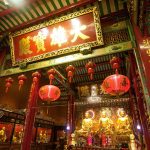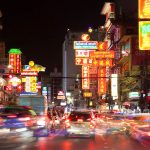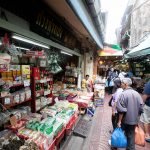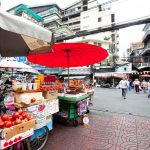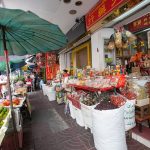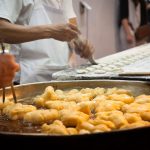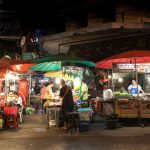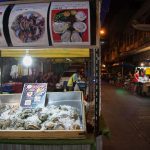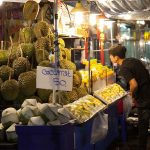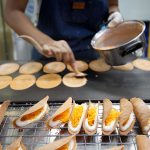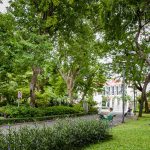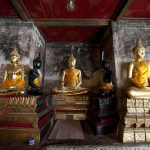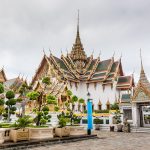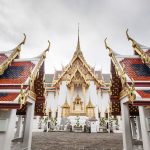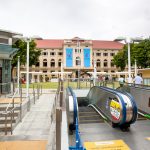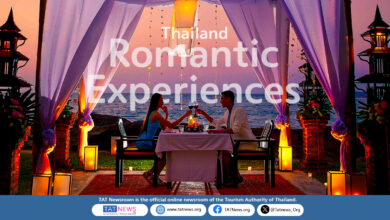The opening of four new MRT stations in Bangkok’s Old City or Rattanakosin neighbourhood and Chinatown, as part of a longer extension to the city’s subway, has made exploration of the area and its various attractions all the more easier.
The four stations are part of a 14-km extension to the MRT Blue Line, which involves 11 new stations in all. These are the Wat Mangkon, Sam Yot, Sanam Chai and Itsaraphap MRT Stations, and they run in this order after the Hua Lamphong MRT Station from where the extension starts. The Hua Lamphong MRT Station is connected to the Hua Lamphong Railway Station, Bangkok’s main station from where trains run throughout the country.
*Hua Lamphong Railway Station
The area of Bangkok covered by the four new stations is home to many of the city’s most spectacular and revered attractions; such as, the Grand Palace, Wat Phra Kaeo (Temple of the Emerald Buddha) and Wat Pho (Temple of the Reclining Buddha). As such, the design and decoration of the stations both celebrates and honours this, and even their above ground architecture aims to help the buildings blend in and look a part of the community.
Between them, the four stations provide an easy and convenient way to go from attraction to attraction, doing away with the need to tackle traffic conditions and having to travel by taxi, tuk-tuk or motorbike taxi. All in all, it makes for a more enjoyable time spent visiting the wonderful sites of the Old City and Chinatown.
Wat Mangkon MRT Station
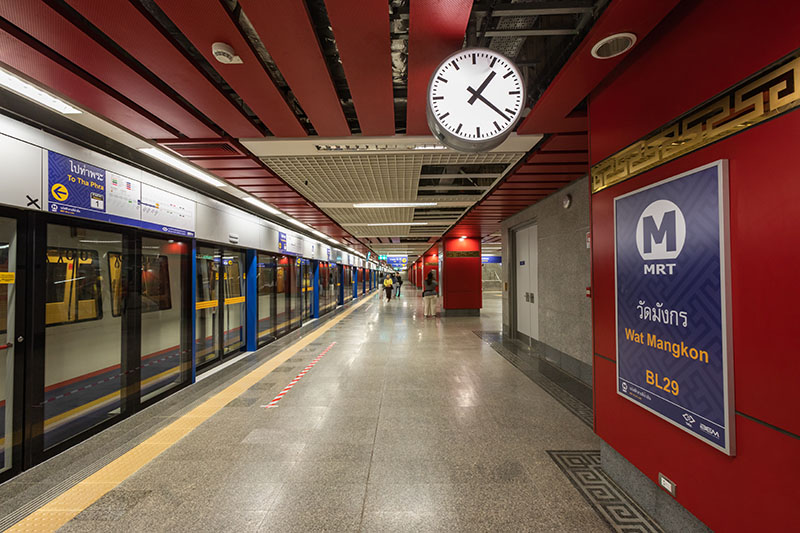 While the Hua Lamphong MRT Station is a short walk from Bangkok’s Chinatown, the Wat Mangkon MRT Station on Charoen Krung Road is in the heart of Chinatown, and this makes it perfect for tourists wanting to experience the pulsating beat and dazzling neon lights of this famous neighbourhood.
While the Hua Lamphong MRT Station is a short walk from Bangkok’s Chinatown, the Wat Mangkon MRT Station on Charoen Krung Road is in the heart of Chinatown, and this makes it perfect for tourists wanting to experience the pulsating beat and dazzling neon lights of this famous neighbourhood.
The station is named after Wat Mangkon Kamalawat (meaning ‘Dragon Lotus Temple’) the city’s largest Chinese Buddhist temple, and features a striking and very elegant décor of red and gold and a dragon-inspired staircase.
*Wat Mongkon Kamalawat
Wat Mangkon Kamalawat is within a comfortable walk of the Wat Mangkon MRT Station. Also known as Wat Leng Nui Yee, the temple is a centre of festivities during important festivals like Chinese New Year and the Vegetarian Festival, and these are indeed fantastic times to visit the attraction. Needless to say anytime is good to visit; the temple’s low rambling structure features dragons playing with a pearl on the roof, and there are various Buddhist, Taoist and Confucian shrines within. All the while, the smoke from countless incense sticks fills the air and adds to the overall atmosphere.
Also within a walk of the Wat Mangkon MRT Station is Sampheng Lane, a cluttered, hectic and fun Chinatown market. Packed along the narrow lane (seriously, it’s about as wide as your outstretched arms) is shop after shop selling all manner of items from jewellery, shoes and watches to toys, fabric and a myriad of exotic foods. If you’re looking for heaps of people and heaps of goods ranging from the Oriental to the everyday, then Sampheng Lane won’t disappoint you.
*Bangkok’s Chinatown on Yaowarat Road
Yaowarat Road – Chinatown’s high street – is a foodies’ dream, attracting locals from across the city and tourists alike to the scintillating array of street-side food including dim sum, noodles, omelettes and much more that’s on offer during the evening.
*Wat Traimit
*Chinatown Gate
Also worth visiting in Chinatown is Wat Traimit, which is actually just a few minutes’ walk from the Hua Lamphong MRT Station. This temple houses a massive gold seated Buddha, and it is a regular pilgrimage for Buddhists as well as curious tourists. Within a stone’s throw of Wat Traimit is the Chinatown Gate, which marks the entrance to this end of Chinatown. It was built in 1999 to commemorate the late King Rama IX’s 72nd birthday.
Sam Yot MRT Station
 Sam Yot MRT station is decorated with a museum-type feel that includes displays of old photographs and drawings that point to the Station’s historical surroundings while the Station building itself is designed to reflect the local street architecture.
Sam Yot MRT station is decorated with a museum-type feel that includes displays of old photographs and drawings that point to the Station’s historical surroundings while the Station building itself is designed to reflect the local street architecture.
This station is situated on the Western outskirts of Chinatown and Sampheng Lane; for example, can be reached within a comfortable walk. Rommaninat Park is a few minutes’ walk from the Station to the north while a short stroll beyond the park is Wat Suthat and the towering red Giant Swing at its entrance.
*Rommaninat Park
*Wat Suthat
*Giant Swing
Wat Suthat is among Bangkok’s oldest and most impressive temples, having been commissioned by King Rama I the Great and completed around the mid-19th century during King Rama III’s reign. The temple features an elegant chapel, magnificent wall murals, and exquisite hand-carved teakwood door panels. The Giant Swing stands over 21 metres tall and is a prominent landmark of the area. The original swing dating from 1784 was replaced in 2004 with a new one crafted from golden teak.
Sanam Chai MRT Station
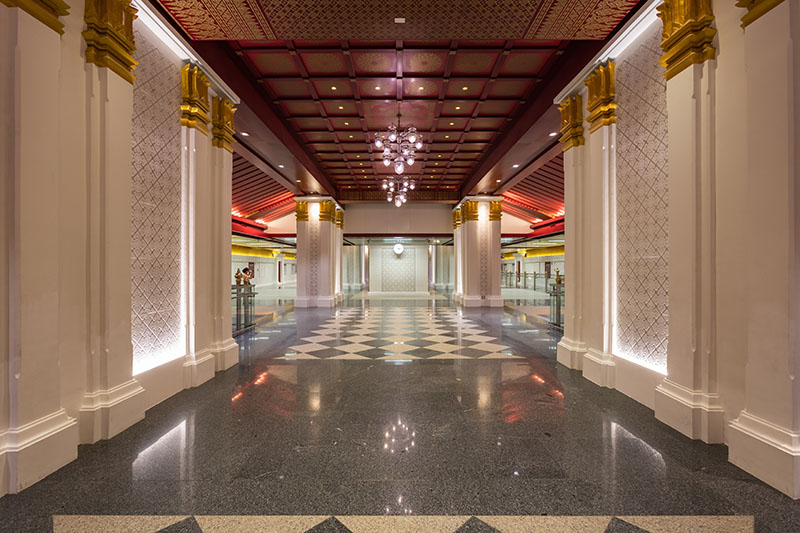
The beautiful, elegant decoration of the Sanam Chai MRT Station with its maroon red and gold colours and stately pillars effect pays tribute to the royal heritage nearby. The Station is around 1 km from the spectacular Grand Palace, Wat Phra Kaeo (Temple of the Emerald Buddha), with Wat Pho (Temple of the Reclining Buddha) located along the way.
*Grand Palace
Right on the Station’s doorstep is Museum Siam, which is dedicated to ‘Thainess’ and the history of the Thai people, their culture and traditions. Far from your average run-of-the-mill museum, this place is full of surprising and thought-provoking displays and exhibits many of them interactive.
*Museum Siam
Bangkok’s most famous landmark, the Grand Palace is the spiritual heart of the Thai kingdom. For 150 years, this was the home of the Thai King, the Royal Court and the administrative seat of government. Today, it stands resplendent and awe-inspiring, and its beautiful architecture a sight to behold. No trip to Bangkok is complete without a visit here.
*Wat Phra Kaeo
Situated on the grounds of the Grand Palace is Wat Phra Kaeo, another must-see for tourists and for Thais the kingdom’s most sacred Buddhist temple. Enshrined within is the highly revered Emerald Buddha statue named Phra Kaeo Morakot or Phra Buddha Maha Mani Rattana Patimakon, which is carved from a single jade block. Other highlights include a model of Angkor Wat, murals telling the Ramayana epic, and the five-metre tall Yaksa Tavarnbal or Gatekeeping Giants.
Half a kilometre or so from the Sanam Chai MRT Station is Wat Pho, another of Bangkok’s best-known temples and also known as the Temple of the Reclining Buddha for the 46-metre long, gold leaf-covered reclining Buddha that it houses. Named Phra Buddha Sai Yat, this is the 3rd largest reclining Buddha in Thailand.
*Wat Pho
Wat Pho was Thailand’s first public university and is today known as a centre of traditional massage and medicine, and is widely considered to be the country’s leading school of massage. Must-sees are the four chapels containing 394 gilded Buddha images, the intricate murals covering the walkways and the Epigraphic Archives of Wat Pho, which were inscribed in 2011 in UNESCO’s Memory of the World Register.
*Pak Khlong Talat
A short walk from the Sanam Chai MRT Station in the other direction is Pak Khlong Talat flower market, the city’s biggest wholesale and retail fresh flower market. While it’s open 24 hours, the best time to see the market is after midnight when it’s at its most lively, and in the pre-dawn hours when truckloads of fresh flowers come in from around the country and when traders and retailers come to buy their stock.
Itsaraphap MRT Station
 Itsaraphap MRT station is on the Thon Buri side of the Chao Phraya River and its decoration features a swan theme, paying tribute to nearby Wat Hongrattanaram, which has ‘swan’ in its name. This station is the best choice for visiting Wat Arun (Temple of Dawn), which is less than a kilometre to the north on the Chao Phraya riverside.
Itsaraphap MRT station is on the Thon Buri side of the Chao Phraya River and its decoration features a swan theme, paying tribute to nearby Wat Hongrattanaram, which has ‘swan’ in its name. This station is the best choice for visiting Wat Arun (Temple of Dawn), which is less than a kilometre to the north on the Chao Phraya riverside.
*Chao Phraya River
*Wat Hongrattanaram
Wat Arun features a different design to other temples in Bangkok, its main Khmer-style tower rising to a height of some 66 metres and with a decoration of seashells and bits of porcelain that glimmer in the sunlight. It is also an internationally recognisable landmark, having been used as a location in several Hollywood movies.
*Wat Arun











